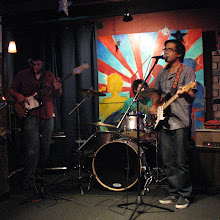Since my fairly documented amplifier failure a couple of weeks ago, the band and me have decided to go forward with the project recording Alec's bass parts as my amplifier awaits completion. We have attempted to record some bass over top the completed drum tracks, but weren't all too satisfied with the resultant sounds. So this second time around we came up with some pretty cool, simple solutions to some age-old questions we had recording bass.
DI versus AMP. Why not both?
Bass guitar (and other low-frequency dominated instruments) do not have as much directionality in a stereo field as instruments that include higher frequency components, such as guitar, snare drum, cymbals, etc. Since about the mid to late 1960's, it has been a common practice to record the electric bass guitar directly through means of a impedance balancing transformer, more commonly known as a "direct inject" box, or DI. This gives a clean, electronic representation of the bass guitar sound as what come straight from the bass guitar's pickups (well, routed through the volume and tone controls on the instrument too). The DI does away with the anomalies associated with bass amplification, speakers, microphones, the environment of the recording space, and the distance the microphone is placed from a speakers, giving a drier, up front, and direct sound, which can sound sterile on it's own.
Another practice is to mike the bass amplifier with a quality microphone; a Sennheiser MD421, AKG D112, Electrovoice RE20 or something of the like. This normally yields a "live, in the room" type sound, which is typically more natural and fuller, though can be hyped in certain frequencies or suffer from distortion as a result of the amplifier or speakers, or phase issues because of distance of the microphone from the speakers. Some engineers however swear by the amp and microphone technique, since it is most true to form when seeing a band perform live.
With modern digital (especially DAW based) recording platforms, higher track counts, almost unlimited track counts are possible, which allows the engineer to record multiple signals dedicated to a single instrument. This can be very useful for bass, allowing the engineer to record both direct and miked bass sounds, and blend them to taste in final mix down. With recording both, it is very, VERY important to observe phase relationship between the direct and miked signals. You should avoid as much as possible phase cancellation and/or phase reinforcement which may cause uneven frequency response of the bass, to avoid a week or otherwise boomy sounding bass sound.
THE ROGUE WAVE.
So Alec and I settled on a scheme where the direct signal would provide a clean bass sound that would represent the full frequency response of his Fender Jazz Bass, while the amplifier would provide a more focused, mid range sound. The amp would be driven a little harder through means of a Boss Super Overdrive or EH Big Muff in order to add some harmonics to give the bass a more pronounced sound in the mix. The challenge was to record a clean DI signal that would be unaffected by the distortion pedals that were on the front end of the bass amp.
Since I didn't have an instrument-level signal splitter box (or any type of splitter for that matter) we used a somewhat unorthodox, if not "incorrect" method. The signal would leave the Jazz Bass, into a DI box, through an XLR cable to my Yamaha MG12 mixer, of which would be then (through one side of the stereo buss) routed through an ART tube compressor then to the A/D conversion. Part of that bass signal would be tapped from the mixer channel via an AUX send, through another instrument cable to a distortion pedal, then to the bass amp. Thankfully this particular amp, a cheap 30W Carlo Robelli bass amp with a single 10" speaker, had an active pickup input. Though line level is not quite the same as a bass with active pickups, the signal level would be closer active level than passive instrument levels. From there, the bass amp was close miked with a Sennheiser MD421 in close proximity with careful attention to phase relationship with the DI signal. The whole setup was then covered in a heavy packing blanket in order to minimize room reflections on the miked bass amp sound.
Note: using a mixer AUX to send an instrument signal is not the recommended way to go when multing a signal to used as both a direct signal and one to be the input signal for an amplifier. A re-amp unit would be much better at doing this, because of impedance and signal level differences. In our situation, it was all we had, and honestly, sounded pretty darn good for how primitive the method is.
Oh yeah, here are some pics of the session. I will post the pictures of the DI/mic signal chain in the near future.
| Alec and the Jazz Bass. |
| Alec and the invisible engineer... I guess I can't take photos and be in the shot at the same time. |
| My modest, yet effective recording setup. Yamaha MG12, ART VLA compressor, M-Audio Fast Track 8R, and Mac Book Pro armed with Pro Tools 8 |

No comments:
Post a Comment